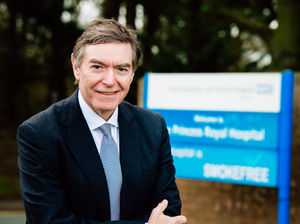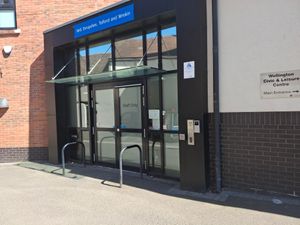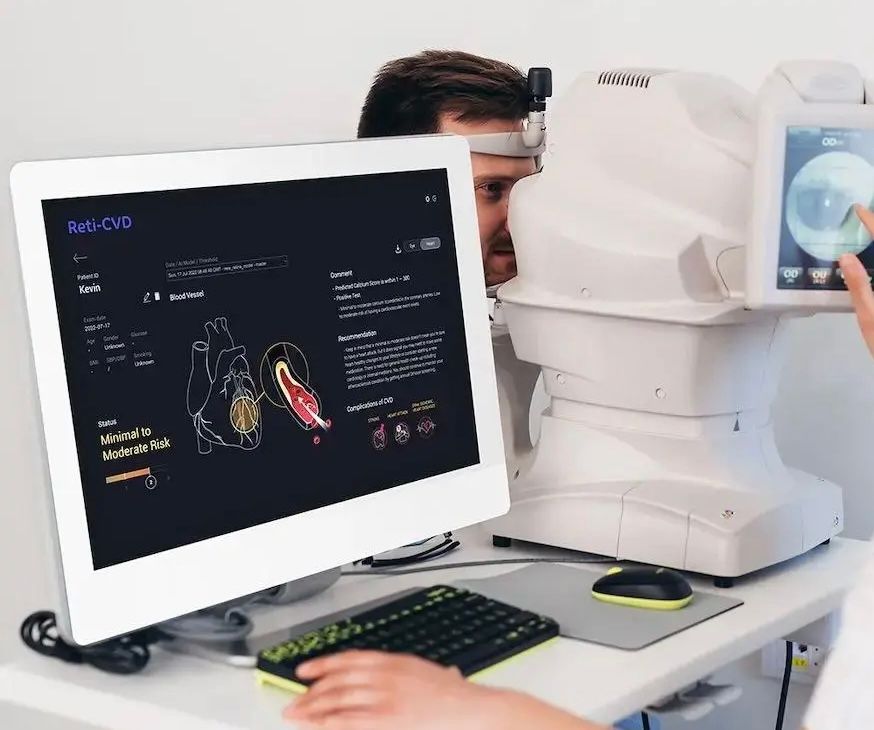'It's the best way forward': Former health minister Philip Dunne calls for public to back Future Fit
Former health minister and Shropshire MP Philip Dunne has called on the county to get behind the controversial Future Fit proposals, saying it is the best way to help secure the investment needed to create world class services.

The Ludlow MP says he has been building a case for major funding for two years, and can now be more upfront in calling on residents and the local NHS to get behind the recommended plans.
He says it will help him encourage NHS England and the Department of Health to make it a priority for investment in the next round of capital allocations.
The decision on whether the Future Fit proposals can proceed to public consultation lies in the hands of NHS England, which wants to know that the whole process can be paid for.
The preferred option, signed off by Shropshire and Telford & Wrekin clinical commissioning groups, includes siting a single emergency department for the county at the Royal Shrewsbury Hospital (RSH).
It could cost in the region of £300 million to bring to fruition.
Responsibility
Mr Dunne said: "A decision to move forward now to seek formal views from Shropshire residents and interested groups, offers the chance for the biggest single public sector investment in Shropshire in living memory.
"This would deliver a brand new emergency department, retaining blue-light emergencies at the heart of the county’s road network with 18 miles of dual-carriageway between Princess Royal Hospital (PRH) and RSH."
Under the recommended model, PRH would take on responsibility for providing planned care and both hospitals would have an urgent care centre.
Mr Dunne says the planned care site would still be able to treat the majority of patients who visit its A&E currently.
He said: "Managing services in this way will mean that patients waiting to have a planned operation will not have their operation cancelled due to unavailability of beds, as the emergency patients that very often need beds will be being cared for on the emergency site.
"Once complete this solution would also provide more opportunity in the future to bring services back into the county from out-of-county hospitals like Stoke and Wolverhampton.
"One of the other benefits, so important for all of us in south Shropshire, is that for the scheme to succeed, significant capacity has to be delivered in providing treatment in community settings; enhancing services through our community hospitals, GPs surgeries, pharmacies and at home. It also requires improving integration of acute care and social care to enable more people to live independently at home.
Travel concerns
"Change is difficult, and given our past experiences in Shropshire, I am not surprised if some are wary, not least regarding travel concerns.
"But I believe securing £320m investment in healthcare in Shropshire, by proceeding with the preferred option for Future Fit, is the best way to secure high quality sustainable acute health services in our county.
"As a Shropshire MP, I have been building the case for major funding for two years, and now can be more upfront in calling on local residents and the local NHS to get behind this proposal.
"This will help me encourage NHS England and the Department of Health to recognise that the best way to give the people of Shropshire, Telford and Mid Wales world class services is to make this case a priority for investment in the next round of capital allocations."
Doctors based at the hospitals have previously said that “doing nothing is not an option” and that services need to be changed to make the hospitals sustainable for the future.
A public consultation on the proposals would also include a second option for PRH to house Shropshire's emergency department and for RSH to become the planned care site.
Health bosses have said that consultant-led women and children's services would have to be on the same site as the emergency department.
However, a range of women and children's services would still be available on the other site, including a midwife-led unit.
'Change is hard, but Future Fit is the way' - Mr Dunne's statement in full

Ludlow MP Philip Dunne explains why he believes the best way forward for healthcare in Shropshire is now to press ahead with the official ‘preferred’ option of siting an A&E department at the Royal Shrewsbury Hospital
For as long as I have been involved in politics in Shropshire, and I understand for several years before, there has been a continuing debate on how best to provide NHS acute care to the people of Shropshire and Telford & Wrekin.
It is widely recognised in the NHS that district general hospitals today and in the future require a population of around half a million people for operational scale to sustain a full range of services, properly staffed 24/7.
There has therefore long been a demographic challenge in sustaining two hospitals with significant overlapping services in Shrewsbury and Telford.
Shropshire’s current population is estimated at 313,500; Telford & Wrekin has around 173,000.
Our hospitals also serve Mid Wales, with around 50,000 people from Powys and further afield using our acute services.
So even factoring in Mid Wales and planned housing growth, it is clear that maintaining two fully serviced acute hospitals, each with A&E departments presents a significant challenge.
Successive national health service reorganisations, by governments of all political persuasions, have failed to take the necessary decisions to put Shropshire’s acute services on a sustainable footing, fit for developing 21st Century healthcare needs. I know people in Shropshire are tired of hearing about the problems we face, and are keen get on with solutions.
We have seen the consequences of indecision over the years, with the loss of some key services out of the county.
Treatments
Anyone who suffers severe trauma or cardiac arrest is now treated not in Shropshire but in Stoke. Some cancer treatments are now provided in Wolverhampton.
This winter, as has been widely reported, the two SaTH hospitals were amongst the worst performing in the country in meeting A&E targets, as the Trust struggles to cope with managing two sub-scale A&E departments.
The latest attempt to reconfigure acute services, known as Future Fit, evolved from the input of over 300 clinicians from right across the health service in Shropshire.
They considered from a clinical perspective how services would best be provided to patients across the county. Their overriding objectives were to address the health implications of changes in Shropshire’s population profile, changing patterns of illness (people requiring more treatment over longer lives, increasingly with multiple conditions like diabetes), higher patient expectations, developments in medical technology, continuing economic challenges, extra costs from fragmented services, and the need to ensure services fit around both urban and rural residents.
Launched in January 2014, Future Fit considered several different options, including a standalone new hospital to be built somewhere between Shrewsbury and Telford. This idea has seen renewed interest recently, but the cost of constructing a brand new hospital, combined with the continuing need to run many services on existing sites at Shrewsbury and Telford, proved prohibitively expensive.
So today, the draft consultation proposes two options, which outline placing the Emergency Care site at either Princess Royal Hospital (PRH) or Royal Shrewsbury Hospital (RSH).
Consultation
The preferred option backed by doctors, nurses, other health professionals and the NHS in Shropshire and nationally, is for the Emergency Care site to be located at the RSH and the Planned Care site at the PRH. It is now time these proposals were put to public consultation.
Under this proposal, women and children’s services would remain on both sites but the consultant led inpatient service would be provided on the emergency site. There will be 24 hour Urgent Care Centres with the capability to treat the majority of patients that currently attend A&E (and where clinically appropriate will receive ambulances) also available at both hospital sites. Adult and children’s outpatient services, day case renal and tests (diagnostics) will continue to be provided at both RSH and PRH. Plans to provide some day-case chemotherapy at PRH will also mean that this service would be provided at both sites.
As the planned Care Site, PRH would offer women and children’s services, with a midwife-led unit, Early Pregnancy Assessment Service (EPAS), antenatal care and scanning as well as postnatal care. There will be adult services, including elective surgery (day case and inpatient) and endoscopy. There will be medical wards for ongoing acute care and rehabilitation. The PRH will have 350 inpatient and day case beds. The Trust also aspires to become a centre of excellence in bariatric services and breast services.
The RSH would house a new state-of-the-art Emergency Department, which would be 50 per cent larger than the two current small A&Es, helping to attract more consultants to address well-known staff shortage issues. This will be alongside a large purpose built Ambulatory Care Unit and a 30-bedded Critical Care Unit. There will also be specialist wards for cardiology (including coronary care unit), gastroenterology, nephrology, neurology, stroke, respiratory and acute medicine, trauma, including orthopaedics and unplanned and complex surgery. women and children’s inpatient services would include obstetrics, neonatal services, children’s inpatient ward and children’s oncology and haematology ward and a Children’s Assessment Unit. Alongside the EPAS unit would be antenatal care, scanning, as well as postnatal care and a midwife-led unit. The RSH site will have approximately 510 inpatient beds.
For me, a decision to move forward now to seek formal views from Shropshire residents and interested groups, offers the chance for the biggest single public sector investment in Shropshire in living memory.
This would deliver a brand new emergency department retaining blue-light emergencies at the heart of the county’s road network with 18 miles of dual-carriageway between PRH and RSH.
Opportunity
The Planned Care site would continue to be able to treat more than six out of 10 of those patients who present at the PRH A&E department today – only the most serious blue-light emergency cases would go to the emergency site.
Managing services in this way will mean that patients waiting to have a planned operation will not have their operation cancelled due to unavailability of beds as the emergency patients that very often need beds will be being cared for on the Emergency site.
Once complete this solution would also provide more opportunity in the future to bring services back into the county from out-of-county hospitals like Stoke and Wolverhampton.
One of the other benefits, so important for all of us in South Shropshire, is that for the scheme to succeed, significant capacity has to be delivered in providing treatment in community settings: enhancing services through our community hospitals, GPs surgeries, pharmacies and at home. It also requires improving integration of acute care and social care to enable more people to live independently at home.
Change is difficult, and given our past experiences in Shropshire, I am not surprised if some are wary, not least regarding travel concerns.
But I believe securing £320m investment in healthcare in Shropshire, by proceeding with the preferred option for Future Fit, is the best way to secure high quality sustainable acute health services in our county.
I have been building the case for major funding for two years behind the scenes, and now can be more upfront in calling on local residents and the local NHS to get behind this proposal.
This will help me encourage NHS England and the Department of Health to recognise that the best way to give the people of Shropshire, Telford and Mid Wales world class services is to make this case a priority for investment in the next round of capital allocations.
I have sent a copy of this article to my former bosses Jeremy Hunt, Secretary of State for Health, and Chancellor Philip Hammond, to urge them to back my call ahead the Chancellor’s Spring Statement next week.





